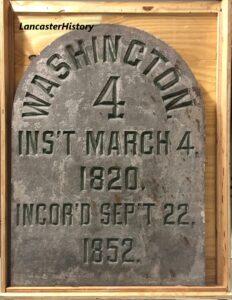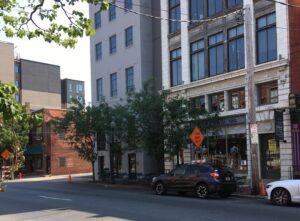The Mystery of the Washington Number 4 Datestone
A Rather Large, Heavy, Unmarked Crate

The recent installation of a high-density storage system in the Decorative Arts Center necessitated a detailed inventory of objects to update locations. During the inventory process, we rediscovered a number of interesting objects that caused us to pause, ask questions, and conduct a little more research. One such item was a miniature wooden cannon set on a wooden carriage marked “POST 118 GAR,” which I wrote about in August. A second object – one much larger and much heavier – also piqued our interest. Housed inside a plain wooden crate, the large marble stone pictured here had no identifying information other than that appearing on its surface.
A thorough review of old accession records showed this to be a datestone from what had been the firehouse for the Washington Fire Company, formed in 1820 as the fourth volunteer fire company in Lancaster. Constructed in 1858, that firehouse was torn down in 1958 to make way for a parking lot! But more about that later….
A New Volunteer Fire Company for Lancaster
“United Be Our Efforts to Quench the Raging Elements”
From the Constitution and By-laws of the Washington Engine & Hose Co., No. 4, 1857
Organized March 4, 1820, and incorporated on September 22, 1852, Washington Engine and Hose Company was the fourth volunteer fire company in the city and the first to be organized after the death of George Washington in 1799. Originally founded as the Mechanics Fire Company of Lancaster, organizers quickly decided at the second meeting held the following week to change the company’s name to Washington in honor of the former president. Previous volunteer fire companies in the city included Union, founded in 1760, and Sun and Friendship, founded in 1763.
Between its founding in 1820 and its integration into the newly created city-wide paid fire service in 1882, Washington Company occupied several buildings in the city, including two separate properties along North Queen Street. In 1822, with the help of a loan from the previously mentioned Sun Fire Company, Washington Company purchased its first Queen Street property from Daniel Heitshue for $400. By the 1850s, the fire company had outgrown the former Heitshue stable property and began to make plans for a larger facility.
A New Home for the Washington Fire Company
According to the Washington Fire Company Minutes Book 1857-1869, Washington Company held a special meeting on June 25, 1858, “to appoint a Committee to Purchase a Site for [a] new Engine and Hose house.” At the next meeting held one week later on July 2, that committee reported that they had purchased the property of William McComsey on the opposite side of North Queen Street from the present facility for $900. At that meeting, the fire company president appointed a building committee to explore options for constructing a new firehouse.
Following the purchase of property and the appointment of a building committee, the fire company moved quickly to approve plans for the design and construction of a new facility. On July 29, 1858, the building committee reported that “they had adopted the Plan of having the Gable End in front.” They also examined building plans presented by Peter Stormfeltz and John Sener [recorded as John Sehner] before approving the plan presented by Sener. Minutes dated August 20 contain an entry thanking Sener “for Services rendered In Drafting the Design of the new house free of Charge” and an entry authorizing trustees to sell the current house.
As noted in the December 28, 1858 issue of the Lancaster Intelligencer, the new firehouse was informally opened to the public on Christmas Eve with a grand ball. On January 1, 1859, Washington Company officially transferred its engine, hose cart, and reel to the building located at 333 North Queen Street, marking its official opening.
A Model of its Kind
An article that appeared in the Lancaster Intelligencer on December 28, 1858, noted that the new firehouse officially opened on Christmas Eve of that year with a grand ball and music provided by Lancaster’s own Keffer Orchestra under the direction of Mr. W.H. Keffer. Washington Henry Keffer, or Professor Keffer as he was known, also operated a music store, taught lessons in his home, and founded the Lancaster Philharmonic Society. In describing the facility, the newspaper noted the following:
The new building is a model of its kind. It commenced in August. It is forty feet deep by twenty-eight in width, built of substantial and highly finished pressed brick, two stories high, and surmounted by a tasteful cupola, in which the company’s bell will be hung; on the top of this is placed the flag-staff. The height of the building from base to cupola is sixty feet, and from the top (owing to the elevated ground on which the house is located,) a fine view of the city and surrounding country is commanded.
The design of the building was furnished by Mr. JOHN SENER, Jr., of the Farmers’ Bank of this city. Although an amateur architect, Mr. S. deserves the highest praise for the eye he had to state, utility, and beauty. It is due to him that the design was voluntarily prepared and generously presented to the company.
Mr. PETER STORMFELTZ, one of our most worthy, industrious, and ingenious young mechanics, supervised the carpenter work. Messrs. MCGEIGAN, adept in their branch of business, did the brickwork.
The frescoing for the Hall is handsomely frescoed and was executed by our neighbor, Mr. MICHAEL SEILING, who, though quite a young man, has had much experience in this branch of painting.
The company owns a large tract of ground in the rear of the Engine House, which they intend to develop as a public park or garden and make a pleasant summer evening resort for our citizens.
Closing the Books
A report of the building committee dated May 6, 1859, listed a number of invoices paid by the treasurer totaling $1261.25 for various projects related to the construction of the new building, including $15.00 to Lewis Haldy for a datestone and $347.36 to Peter Stormfeltz “and others” for carpentry work. The cost of the new firehouse was estimated to be between $3500 and $4000.
On July 15, 1859, the Board of Trustees reported to the officers and members of the Washington Engine and Hose Company that the old engine and hose house had been sold to Henry Frank for $500.
The End of an Era
The era of these grand firehouses was short-lived. Shortages of labor and materials caused by World War I, coupled with changing tastes in architectural style, meant that firehouses in the post-war period were smaller and less ornate, providing only enough room for equipment and the needs of the firefighters.
Volunteer fire companies served the citizens of Lancaster until December 1881, when Lancaster approved an ordinance establishing a paid fire department. Lancaster took over the operation of Washington Fire Company in April 1882. At that time, it became the home of No. 4 Engine Company. The building was torn down in 1958 to make way for a parking lot after completing a new firehouse on North Duke Street. Chief Engineer Edward H. Koerkle ensured the datestone was donated to the Lancaster County Historical Society that same year.
Like the Washington Fire Company firehouse, many buildings pictured on the Sanborn Insurance map of 1886 are no longer in existence. Using the fire hydrant in the center of the block located just to the north of the firehouse as a constant, the large complex of buildings to the right of the parking lot was once home to the Keppel Candy Company. Now known as the Keppel Building, the structure is home to a mix of retail, commercial, and residential spaces. The brick building to the left of the hydrant is now home to the Pennsylvania Guild of Craftsmen.
Now properly cataloged and documented, this object joins our substantial collection of objects associated with the various volunteer fire companies that once protected the citizenry of Lancaster City. Indeed, while every object has a story to tell, sometimes it takes a little research and a lot of digging to bring that story to life. And, after all, isn’t that what museums are all about?
From Object Lessons






